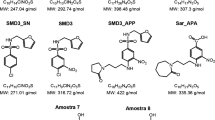Abstract.
To study the role the phenyl group plays in producing local anesthetic block, a sequence of n-alkanols and phenyl-substituted alkanols (Φ-alkanols) were characterized in their ability to block Na channels. The sequence of n-alkanols studied possess 3–5 carbons (propanol-pentanol). The action of phenol and 3-Φ-alkanols (benzyl alcohol, phenethyl alcohol, 3-phenyl-1-propanol) were also studied. Na currents (I Na ) were recorded from single frog skeletal muscle fibers using the Vaseline-gap voltage clamp technique. I Na s were recorded prior to, during, and following the removal of the solutes in Ringer's solution.
All alkanols and phenol acted to block I Na in a dose-dependent manner. Effective doses to produce half block (ED50) of I Na or Na conductance (G Na ) were obtained from dose-response relations for all solutes used. The block of G Na depended on voltage, and could be separated into voltage-dependent and -independent components. Each solute acted to shift G Na -V relations in a depolarized direction and reduce the maximum G Na and slope of the relation. All solutes acted to speed up I Na kinetics and cause hyperpolarizing shifts in steady-state inactivation. The magnitude of the kinetic changes increased with dose.
Size was an important variable in determining the magnitude of the changes in I Na ; however, size alone was not sufficient to predict the changes in I Na . ED50s for G Na and AP block could be predicted as a function of intrinsic molar volume, hydrogen bond acceptor basicity (β) and donor acidity (α), and polarity (P) of the solutes.
The equivalency of ED50 predictions for AP and G Na block can be explained by the fact that AP block arises from channel block and solute-induced changes in I Na kinetics. Φ-alkanols were more effective at blocking and inactivating Na channels than their unsubstituted counterparts. Phenyl-substituted alkanols are more likely to interact with the channel than their unsubstituted counterparts.
Similar content being viewed by others
Author information
Authors and Affiliations
Additional information
Received: 11 August 2000/Revised: 21 December 2000
Rights and permissions
About this article
Cite this article
Kondratiev, A., Hahin, R. ED50 G Na Block Predictions for Phenyl Substituted and Unsubstituted n-Alkanols. J. Membrane Biol. 180, 123–136 (2001). https://doi.org/10.1007/s002320010064
Issue Date:
DOI: https://doi.org/10.1007/s002320010064




